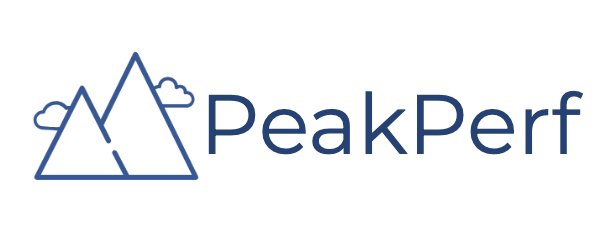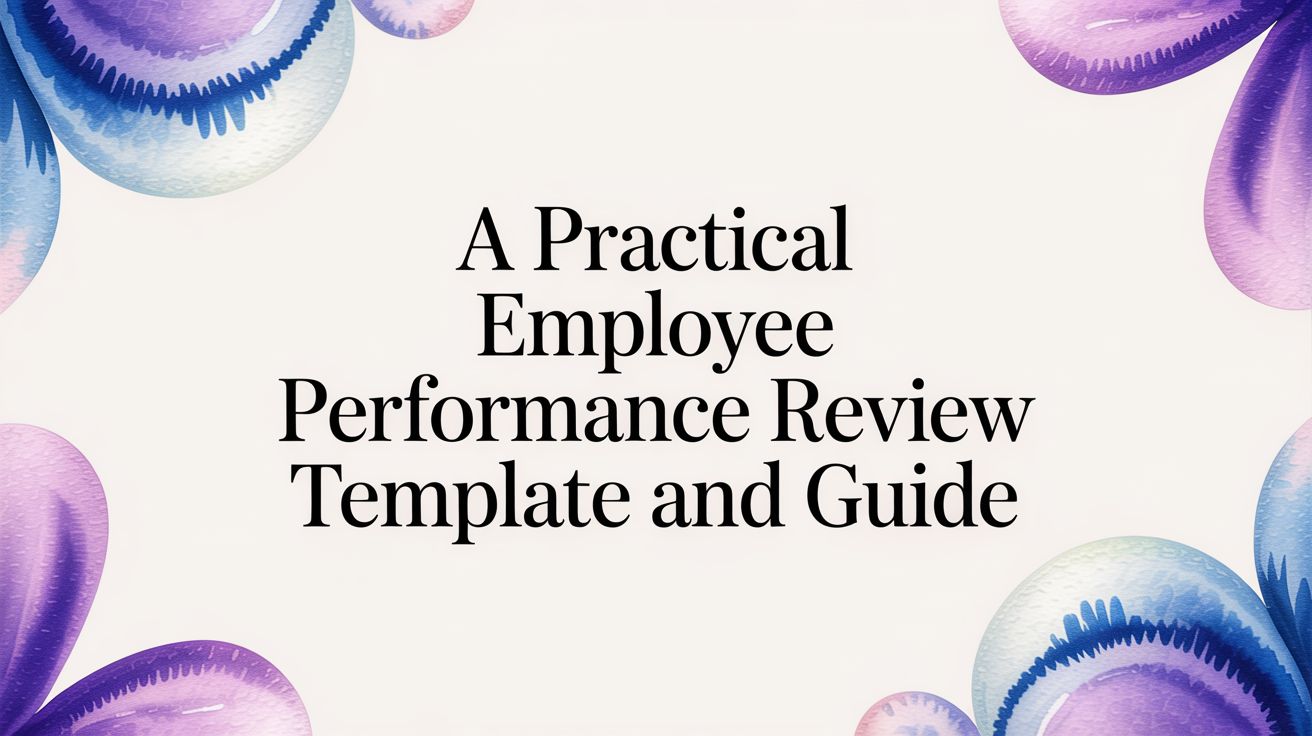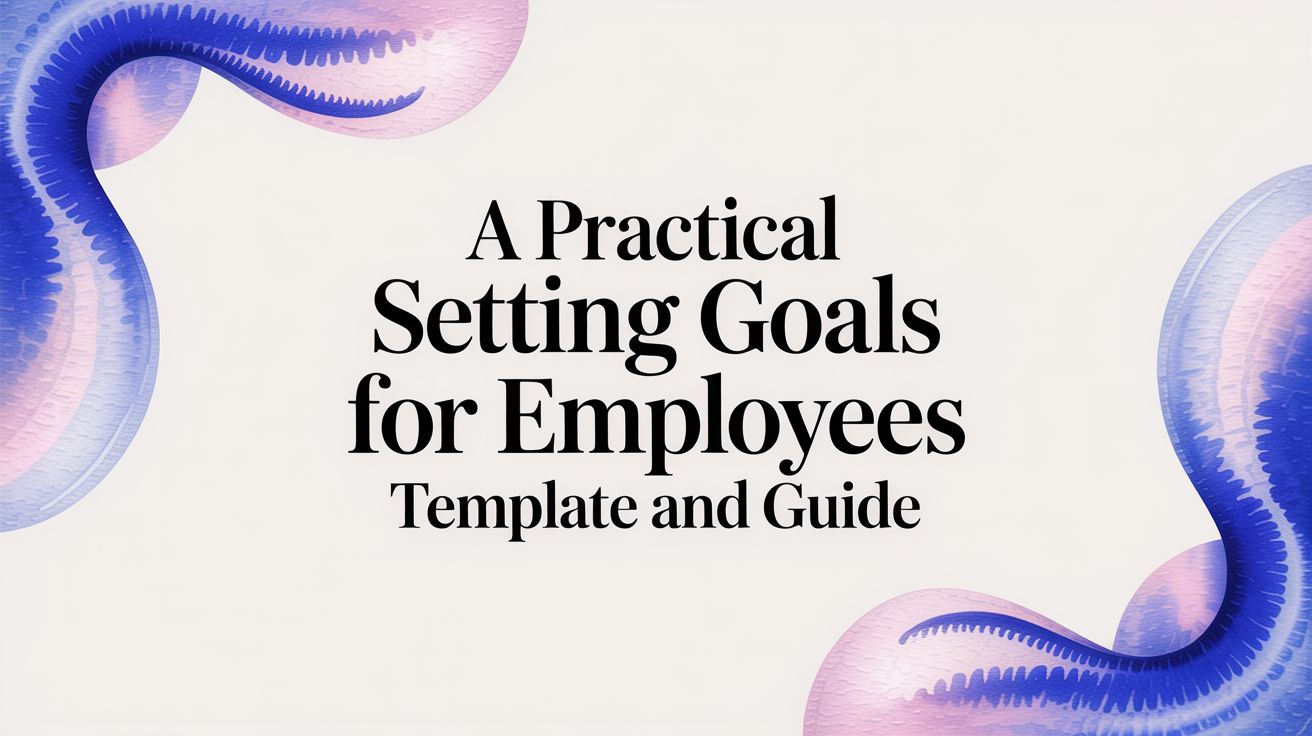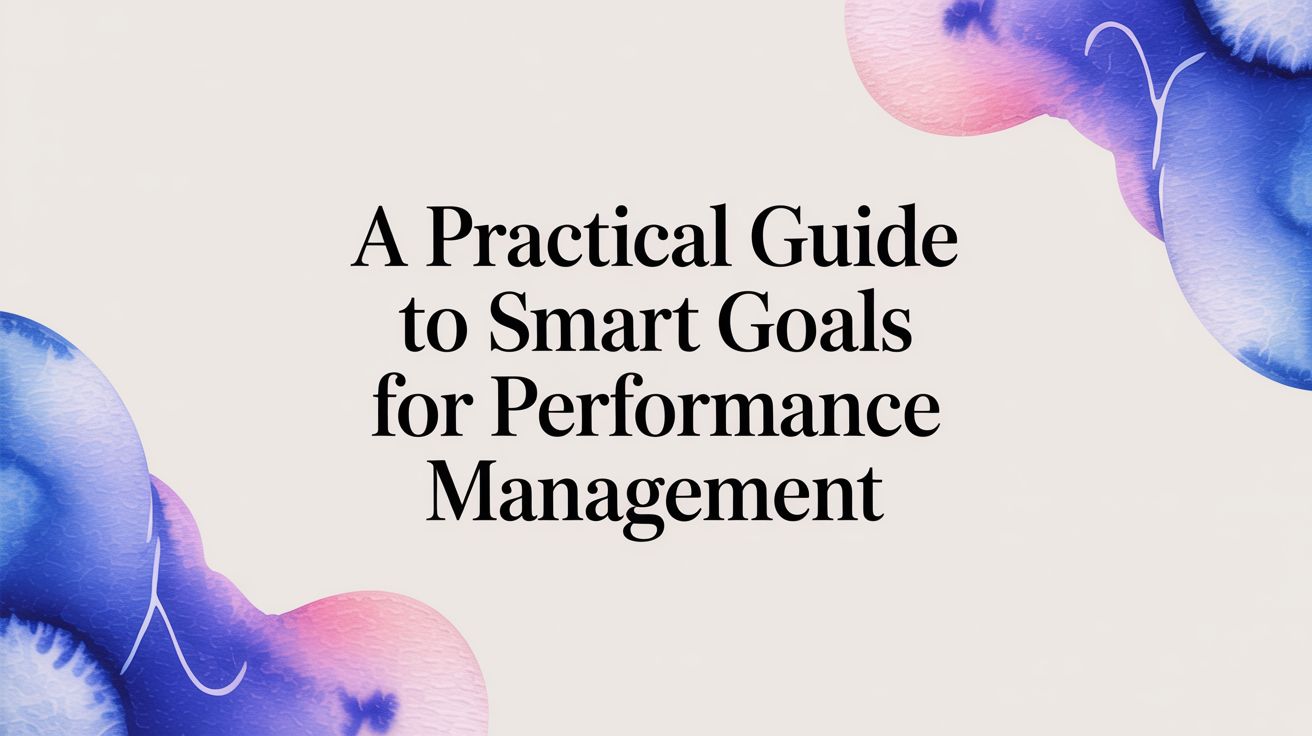9 Essential Management Feedback Examples for 2025

Giving effective feedback is a core management skill. Clear communication guides your team, corrects performance issues, and builds strong professional relationships. Many managers struggle to find the right words. They worry about sounding too critical or unclear, which leads them to avoid important conversations. This hesitation stunts employee growth and allows small problems to become significant obstacles.
This guide provides specific, actionable management feedback examples for common situations you face. You will find practical scripts and frameworks for clarity and impact. Learn how to structure your conversations to be productive, supportive, and focused on development. We will move beyond generic advice and give you the language needed to handle difficult discussions, deliver praise, and coach your team.
Inside this list, you will learn how to:
- Structure corrective feedback using models like Situation-Behavior-Impact (SBI) to remove emotion and focus on facts.
- Deliver reinforcing praise that encourages positive behaviors and makes your team members feel valued.
- Adapt your approach for different scenarios, including performance reviews, remote check-ins, and coaching moments.
- Build confidence in your ability to communicate effectively and foster a culture of trust and continuous improvement.
Each example includes a strategic breakdown explaining why it works and how you can customize it. Use these templates to prepare for your next feedback session and transform your management approach from uncertain to influential. You will gain the tools to deliver feedback that helps your team members grow and succeed.
Corrective Feedback Using the SBI Model
Corrective feedback addresses performance that does not meet expectations. The Situation-Behavior-Impact (SBI) model provides a clear, fact-based structure that removes judgment. This approach makes the feedback easier for your employee to hear and act upon. It separates the person from the behavior. The conversation focuses on specific, observable actions and their direct consequences. This precision is essential for creating a shared understanding of the problem and agreeing on a path forward.
How SBI Works
The SBI framework breaks feedback into three simple, objective parts:
- Situation: You first state the specific "when and where" the behavior happened. This grounds the feedback in a concrete moment.
- Behavior: Next, you describe the exact, observable behavior. You avoid assumptions or interpretations of intent.
- Impact: Finally, you explain the direct result of the behavior. This connects the action to a tangible outcome, like its effect on team productivity, a client, or project timelines.
Management Feedback Examples Using SBI
Example 1: Missed Deadlines
- Situation: "During Tuesday's project planning meeting for the Q3 launch..."
- Behavior: "...you shared a timeline for the design mockups that was two days past the client's hard deadline."
- Impact: "...This caused the client to express concern about our ability to deliver, and now the account team has to reset expectations."
Example 2: Meeting Interruption
- Situation: "In this morning’s team stand-up..."
- Behavior: "...you spoke over Sarah while she was giving her update."
- Impact: "...As a result, she lost her train of thought and we did not get a clear picture of her progress on the main task."
Why This Method is Effective
The SBI model works because it is objective and non-confrontational. You focus strictly on facts (the situation, the specific action, and the outcome), so you remove accusatory language. This prevents the employee from becoming defensive. Instead of feeling personally attacked, they understand the issue and engage in a productive conversation about solutions. This approach builds trust and makes difficult conversations straightforward.
Radical Candor Framework
The Radical Candor framework, developed by Kim Scott, is built on a simple principle: Care Personally while you Challenge Directly. It guides managers to give clear, honest feedback while showing genuine concern for their employees. This approach fosters a culture of trust where critique is a tool for growth, not a personal attack. It helps you deliver difficult messages effectively because the employee knows you are invested in their success.

How Radical Candor Works
Radical Candor operates within a four-quadrant framework defined by two axes: "Care Personally" and "Challenge Directly." The goal is to stay in the top-right quadrant.
- Radical Candor: You give specific, direct feedback from a place of genuine care. This is honest and helpful.
- Obnoxious Aggression: You challenge directly but fail to show you care. This is praise that feels insincere or criticism that feels brutal.
- Ruinous Empathy: You care personally but fail to challenge directly. You avoid necessary feedback to spare someone's feelings, which harms their growth.
- Manipulative Insincerity: You neither care nor challenge. This is dishonest praise or vague, non-committal feedback.
Management Feedback Examples Using Radical Candor
Example 1: Underwhelming Presentation
- "John, I care about your growth here, so I want to be direct about your presentation this morning. The data was solid, but your main points were not clear, which confused the client. I know you can deliver a much stronger message. Let's block 30 minutes to restructure the key slides together for next time."
Example 2: Acknowledging Strong Performance
- "Sarah, I need to tell you how much your work on the new dashboard helped the team. Challenging our old assumptions about the data was a bold move, and it paid off by revealing a major new opportunity. That kind of critical thinking is exactly what we need. Great job."
Why This Method is Effective
Radical Candor is effective because it humanizes feedback. You establish a foundation of personal care, so you earn the right to challenge your employees directly. This builds psychological safety, allowing for tough conversations that lead to real improvement. It stops managers from falling into the common traps of being either too harsh or too soft. It provides a balanced and repeatable model for giving management feedback that both supports and develops your people.
360-Degree Feedback System
A 360-degree feedback system moves beyond the traditional top-down review. It collects confidential, anonymous feedback for an employee from the people who work around them, including their manager, peers, and direct reports. This method provides a comprehensive view of an employee’s skills, behaviors, and impact from multiple perspectives. It is useful for leadership development because it highlights how a person's actions are perceived across the organization.

How 360-Degree Feedback Works
The process is structured to gather balanced input and identify key themes. It avoids relying on a single source of truth and instead builds a complete picture of performance.
- Gather Input: A group of 8 to 12 participants (manager, peers, direct reports) complete a standardized questionnaire about the employee.
- Analyze Themes: The feedback is aggregated into a report that identifies common patterns and key development areas. Individual responses are kept anonymous.
- Discuss and Plan: The manager or an HR partner helps the employee interpret the report, focus on recurring themes, and create an actionable development plan.
Management Feedback Examples from a 360-Degree System
The output is a summary of themes, not direct quotes. Here are examples of insights a manager might receive.
Example 1: Feedback for a Project Manager
- Manager's Input: "Excels at project planning and keeping tasks on schedule."
- Peer Input (Theme): "Communication during project shifts can be abrupt. We are sometimes unsure of the new direction."
- Direct Report Input (Theme): "Great at delegating tasks but could offer more context on why decisions are made."
Example 2: Feedback for a Team Lead
- Manager's Input: "Consistently hits team performance targets."
- Peer Input (Theme): "Collaborates well within our team but is less visible in cross-departmental initiatives."
- Direct Report Input (Theme): "Provides strong support and removes roadblocks but does not always make time for individual career development conversations."
Why This Method is Effective
The 360-degree method is effective because it uncovers blind spots a manager might not see. It gives employees a clear understanding of their reputation and impact on different groups. The process focuses on aggregated themes instead of individual comments. So it feels less like a personal critique and more like objective data for growth. This holistic view empowers individuals to develop skills like communication, collaboration, and leadership with greater self-awareness.
Continuous Feedback/Real-Time Feedback
Continuous feedback moves away from the traditional annual review cycle toward frequent, informal check-ins. This approach aligns with agile work environments by providing opportunities for immediate course correction and timely recognition. You make feedback a regular part of the workflow. So you create a culture where improvement is a constant, collaborative process, not a once-a-year event. This method is important for keeping performance aligned with changing goals.
How Continuous Feedback Works
This model integrates feedback into daily and weekly routines. Managers share observations in the moment or during scheduled conversations instead of saving them for a formal review.
- Frequency: Feedback is delivered daily, weekly, or as needed, often during 1-on-1s, stand-ups, or immediately after an event.
- Formality: The tone is informal and conversational, designed to feel like a natural part of the working relationship.
- Focus: It addresses both positive and developmental points with equal importance, reinforcing good habits and correcting missteps quickly.
Management Feedback Examples for Continuous Feedback
Example 1: Positive Recognition in a Team Meeting
- Situation: "Just now, during the client presentation..."
- Behavior: "...you handled that difficult question about the budget overrun with complete transparency and offered a clear solution."
- Impact: "...The client was visibly impressed, which strengthened their trust in our team and put the project back on solid ground. Great job."
Example 2: Quick Correction in a 1-on-1
- Situation: "I noticed in the project update emails you sent this week..."
- Behavior: "...the key performance metrics were missing from the summary section."
- Impact: "...Our leadership team relies on those numbers to make quick decisions, so their absence slows down their review process. Let's make sure they are included up front next time."
Why This Method is Effective
Continuous feedback is effective because it is timely and relevant. Addressing behaviors immediately makes the feedback more impactful and easier for the employee to act upon. This constant communication loop prevents small issues from becoming large problems. It ensures employees feel consistently supported and valued. It builds psychological safety, making team members more receptive to constructive criticism and more engaged in their own growth.
GROW Model Feedback
The GROW model is a coaching framework that helps employees find their own solutions. It stands for Goal, Reality, Options, and Will. You guide an employee through structured questioning instead of telling them what to do. This approach fosters critical thinking, ownership, and long-term professional development. It is one of the most effective management feedback examples for building employee autonomy.
How GROW Works
The GROW framework guides a conversation through four distinct phases:
- Goal: You start by helping the employee define what they want to achieve. The goal should be specific and inspiring.
- Reality: Next, you explore the current situation. This step helps the employee gain a clear, objective understanding of where they stand right now.
- Options: You then brainstorm potential actions or strategies. The focus here is on generating multiple possibilities without initial judgment.
- Will: Finally, you help the employee commit to specific next steps. This phase solidifies their plan and establishes accountability.
Management Feedback Examples Using GROW
Example 1: Improving Presentation Skills
- Goal: "What would an ideal presentation look like for you in the next all-hands meeting?"
- Reality: "Thinking about your last presentation, what parts went well, and what aspects felt challenging?"
- Options: "What are two or three different ways you could approach preparing for this next one?"
- Will: "So, which specific step will you take first, and by when will you do it?"
Example 2: Managing Workload
- Goal: "What does successfully managing your current project workload look and feel like?"
- Reality: "What is currently taking up most of your time, and what is getting in the way of your progress?"
- Options: "What resources could help you? What tasks could be delegated or de-prioritized?"
- Will: "What is one change you will commit to making this week to better manage your time?"
Why This Method is Effective
The GROW model is effective because it empowers the employee. It shifts the manager’s role from a director to a facilitator. This process encourages self-reflection and problem-solving, which builds an individual’s confidence and capabilities. It is best suited for developmental conversations, not disciplinary issues. For situations requiring structured improvement, you may need a different approach. You can get more information about writing a performance improvement plan to handle those cases. This method transforms feedback from a top-down directive into a collaborative partnership for growth.
Strengths-Based Feedback
Strengths-based feedback focuses on identifying and amplifying what your employees do best. This approach centers on leveraging existing talents to drive performance and growth instead of primarily correcting weaknesses. Popularized by Gallup and Marcus Buckingham, it operates on the principle that people achieve more when they build upon their natural capabilities. This method creates a positive, motivating environment where employees feel valued for their unique contributions.
How Strengths-Based Feedback Works
This framework involves a proactive, development-oriented mindset. You shift the conversation from "what's wrong" to "what's strong" and how to use that strength more effectively.
- Identify: Pinpoint an employee's core strengths through observation, performance data, or assessment tools.
- Acknowledge: Clearly and specifically recognize the strength in action.
- Align: Connect that strength to team goals, new responsibilities, or development opportunities.
Management Feedback Examples Using Strengths
Example 1: Encouraging Leadership
- Situation: "In our last sprint retrospective..."
- Behavior: "...you did an excellent job of making sure everyone contributed, and you summarized the key takeaways concisely."
- Impact: "...This has greatly improved our team's communication. Because of this natural skill for facilitation, I would like you to lead our next cross-departmental project kickoff."
Example 2: Leveraging Analytical Skills
- Situation: "When reviewing the quarterly sales data..."
- Behavior: "...I was impressed with how you identified the subtle trend in customer churn before anyone else."
- Impact: "...Your analytical skills are a major asset. Let's get you involved in the new market analysis initiative to help shape our strategy for next year."
Why This Method is Effective
Strengths-based feedback is effective because it increases employee engagement and confidence. When you recognize and invest in what someone is already good at, they feel more competent and motivated. This approach creates a virtuous cycle. Employees become more productive in roles that fit their talents, which leads to better results and greater job satisfaction. It turns performance conversations into opportunities for growth, not correction.
Nonviolent Communication (NVC) Feedback
Nonviolent Communication (NVC) is a feedback framework that focuses on expressing yourself with empathy and honesty. Developed by Marshall Rosenberg, this approach helps managers deliver difficult messages by connecting their own feelings and needs to an observable situation. It creates a space for compassionate dialogue instead of conflict. This makes it one of the most effective management feedback examples for sensitive topics. The goal is to be understood and to understand your employee in return.
How NVC Works
The NVC model guides you through four clear steps to structure your feedback. This process separates observation from judgment and connects actions to human needs.
- Observation: State a specific, factual observation without any evaluation or judgment. What did you see or hear?
- Feeling: Express the emotion you feel in response to the observation. Use "I" statements.
- Need: Explain the need, value, or desire that is causing your feeling.
- Request: Make a clear, positive, and actionable request for what you would like going forward.
Management Feedback Examples Using NVC
Example 1: Missed Deadlines
- Observation: "When the project report was submitted on Friday instead of Wednesday..."
- Feeling: "...I felt frustrated and anxious."
- Need: "...because I need our team to be reliable so we can manage client expectations effectively."
- Request: "...Could you commit to providing a status update three days before future deadlines if you think you might be late?"
Example 2: Disengaging During Meetings
- Observation: "I noticed you were on your phone during most of the team brainstorming session today."
- Feeling: "...I feel concerned."
- Need: "...because I need everyone's full participation to ensure we generate the best ideas."
- Request: "...Would you be willing to keep your phone away during our team meetings next week?"
Why This Method is Effective
NVC is effective because it humanizes feedback and fosters connection. You state your feelings and needs, so you invite vulnerability and empathy from your employee. This approach avoids blame and focuses on finding a collaborative way to meet everyone's needs. It transforms a potentially adversarial conversation into a partnership, reinforcing psychological safety and strengthening your working relationship.
Data-Driven/Metrics-Based Feedback
Data-driven feedback grounds performance discussions in quantifiable metrics and measurable outcomes. This approach moves the conversation away from subjective impressions and toward objective evidence. It is valuable in roles where performance can be measured directly, like sales, operations, or software development. It reduces bias and creates a clear, shared understanding of success.

How Data-Driven Feedback Works
This method involves tracking key performance indicators (KPIs) and using them as the foundation for feedback. You present specific data points to an employee to illustrate their performance against goals, past results, or team benchmarks. The goal is to anchor the conversation in factual results. This makes it easier to discuss achievements and identify areas for improvement.
- Identify Key Metrics: First, you select the specific, meaningful data points that directly relate to the employee's core responsibilities.
- Provide Context: You then present the data, explaining the target, benchmark, or previous period's performance for comparison.
- Discuss the "Why": Finally, you and the employee discuss the factors that influenced the numbers, both positive and negative.
Management Feedback Examples Using Data
Example 1: Positive Sales Performance
- "Looking at your Q3 results, you closed $850,000 in new business, which is 15 percent above your target of $740,000. Your conversion rate from demo to close also increased from 18 percent in Q2 to 22 percent. This is a fantastic result. What do you think contributed to that jump in conversions?"
Example 2: Software Development Quality
- "On the last sprint, you completed 12 of your 15 assigned story points on time, hitting our 80 percent completion goal. The bug report rate for your committed code was 2.1 per 1,000 lines, which is well below the team's average of 4.5. This high quality is saving the QA team significant time."
Why This Method is Effective
Data-driven feedback is effective because it is objective and transparent. Numbers provide a neutral starting point for a conversation, which minimizes feelings of personal judgment and defensiveness. It allows you to precisely pinpoint successes and challenges. This makes discussions more focused and productive. This approach empowers employees by giving them clear visibility into what success looks like and how their performance is measured.
Peer Feedback/360 Lite Approach
The Peer Feedback or 360 Lite approach gathers performance insights from a small, curated group of colleagues. This streamlined version focuses primarily on input from three to five teammates, unlike a full 360-degree review that includes feedback from managers, direct reports, and peers. This method provides a multifaceted view of an employee's collaborative skills without the administrative weight of a comprehensive 360 assessment. It is useful for highlighting strengths and development areas in team-based environments.
How the 360 Lite Approach Works
This process collects targeted feedback on specific competencies, often through structured, anonymous surveys. The goal is to give the employee a clear picture of how their contributions are perceived by those they work with most closely.
- Select Peers: You and your employee collaboratively choose a small, diverse group of peers who have worked closely with them.
- Use Structured Questions: Provide specific prompts focused on areas like collaboration, communication, and project contributions.
- Consolidate and Deliver: You collect the anonymous feedback, identify recurring themes, and present a summary to the employee.
Management Feedback Examples Using a 360 Lite Approach
Example 1: Feedback on Collaboration
- Prompt: "Please describe a time when [Employee's Name] helped you or the team overcome a challenge. What specific actions did they take?"
- Consolidated Theme: "Your peers consistently mentioned your willingness to help debug code. They said you are approachable and excellent at explaining complex problems, which helped the team meet the last sprint goal."
- Impact: This reinforces positive collaborative behavior and gives the employee a specific example of their value to the team.
Example 2: Feedback on Project Participation
- Prompt: "On the recent Q4 project, what is one thing [Employee's Name] could do to be an even more effective teammate?"
- Consolidated Theme: "Multiple colleagues suggested you share your progress updates earlier in the project lifecycle. They value your insights but feel they sometimes receive them too late to incorporate them without causing delays."
- Impact: This provides a clear, actionable area for improvement that directly affects team efficiency.
Why This Method is Effective
The 360 Lite approach is effective because it provides diverse perspectives with minimal complexity. It gives employees insight into their blind spots and strengths from the viewpoint of their collaborators. You encourage honest, constructive input that an employee might not otherwise receive by keeping the process focused and anonymous. This type of management feedback example builds self-awareness and supports targeted professional development within a team context.
9 Management Feedback Approaches Compared
Make Every Feedback Conversation Count
You now have a comprehensive toolkit of management feedback examples. You have seen how frameworks like the SBI model provide structure for corrective conversations. You also see how strengths-based feedback builds momentum and how the GROW model transforms feedback into a coaching opportunity. The goal is not to memorize scripts. The goal is to internalize the principles behind them so you can adapt your approach to any person or situation.
The most effective managers understand that feedback is not a one-time event. It is a continuous cycle of observation, conversation, and growth. Your commitment to providing consistent, high-quality feedback is the single most significant investment you can make in your team's development and performance. Each example shared, from addressing missed deadlines to celebrating a project win, demonstrates a core truth: clarity is kindness. Vague feedback creates anxiety and confusion. Specific, behavioral feedback creates a clear path forward.
From Examples to Actionable Habits
Seeing these management feedback examples is the first step. Turning them into a consistent leadership practice is the next. Your objective is to move from needing a template for every conversation to developing an intuitive sense of what a situation requires. This means practicing these techniques until they become second nature.
Start by focusing on one or two frameworks that resonate with your leadership style.
- For corrective feedback, make the SBI (Situation-Behavior-Impact) model your default. It removes judgment and focuses everyone on objective facts.
- For positive reinforcement, go beyond "good job." Detail the specific actions and explain why they were valuable to the team or the company. This shows you are paying attention and helps the employee replicate their success.
- For career development, use the GROW (Goal-Reality-Options-Will) model. It empowers your team members by making them active participants in their own growth plans.
Remember that feedback is a dialogue. After you share your observations, pause and listen. Ask open-ended questions like, "What are your thoughts on this?" or "How did you see the situation?" This transforms a monologue into a productive conversation, building trust and psychological safety.
Building a Culture of Constructive Communication
Your role as a manager extends beyond individual conversations. You are the architect of your team's communication culture. When you model how to give and receive feedback effectively, you set the standard for everyone else. This creates a positive loop where team members become more comfortable sharing feedback with each other, leading to faster problem-solving and stronger collaboration.
The ultimate goal is to build a team where feedback is viewed as crucial information for improvement, not as criticism. It becomes a normal, expected, and valued part of the daily workflow. This environment does not happen by accident. It is the direct result of intentional, consistent effort from leadership. By using the diverse management feedback examples in this guide, you are not just managing performance. You are actively cultivating a culture of transparency, trust, and continuous improvement that will serve as a foundation for sustained success.




